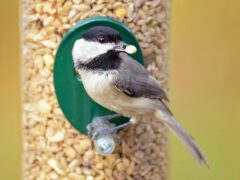Slaty-backed Gull Photo Gallery
Breeding adult
A large, stocky, pot-bellied gull with short pink legs, short wings, and a hefty bill. Breeding adult has a white head and underparts, dark gray upperparts, and a yellow bill with a red spot.
© Ian Davies / Macaulay LibraryAlaska, May 22, 2013Nonbreeding adult
Nonbreeding adult has a heavily streaked head and upper breast. In flight, adult shows an all-white tail, a broad white trailing edge on the inner wings, and a diagnostic “string of pearls” pattern near the wingtips: small white arcs separating the dark gray feathers from black wingtips.
© Ian Davies / Macaulay LibraryHokkaido, December 26, 2013Nonbreeding adult
A large, full-bodied gull with pink legs in all plumages. Nonbreeding adult has dark gray upperparts, a broad white tertial crescent in front of the black-and-white wingtips, a yellow bill with red mark, and a heavily streaked head with a darker patch around the eye.
© Joel Strong / Macaulay LibraryNew York, December 26, 2020Not all videos have soundFirst year
Slaty-backed Gulls take four years to transition to full adult plumage. First year birds are quite variable, but note the short pink legs, thick black bill, dark mask around the eye, and brown wingtips and tail.
© Ian Davies / Macaulay LibraryHokkaido, December 27, 2013First year
First-winter birds can look pale and bleached.
© Pam Rasmussen / Macaulay LibraryHokkaido, March 14, 2015Breeding adult
An opportunistic, omnivorous feeder, with some individuals specializing in plundering seabird colonies.
© Jian-Long(建龍) WU(吳) / Macaulay LibraryHokkaido, June 20, 2024Not all videos have soundSecond year
Early second-year birds have a slaty mantle contrasting with brown-and-white wing coverts. Second-year birds develop a pinkish base to the bill.
© Blake Matheson / Macaulay LibraryCalifornia, February 06, 2018Second year
This species is largely restricted to the coast of northeastern Asia, but nonbreeding and wintering birds regularly occur in western Alaska.
© Markus Deutsch / Macaulay LibraryAlaska, June 18, 2009In flight
In flight, note the strikingly patterned underwing, with white wing linings, mostly gray flight feathers, broad white trailing edge to inner wing, and black wingtips with white spots.
© Josep del Hoyo / Macaulay LibraryHokkaido, February 06, 2010Not all videos have soundThird year
Third-year birds are similar to adults, but have some brown on the wings and some black markings on a horn-colored bill. Note the wide white crescents on the back and in front of the black-and-white wingtips.
© Nick Hajdukovich / Macaulay LibraryAlaska, January 17, 2011Third year
In flight, third-year individuals are similar to adults, but note the broad black tail band and brown blotches in the wings. The adult “string of pearls” pattern in the outer flight feathers is often less conspicuous in third-year birds.
© Ian Davies / Macaulay LibraryHokkaido, December 26, 2013Compare with Similar Species
Click on an image to compare
Species in This Family
Gulls, Terns, and Skimmers(Order: Charadriiformes, Family: Laridae)
More to Read
Don't miss a thing! Join our email list
The Cornell Lab will send you updates about birds,
birding, and opportunities to help bird conservation.









































